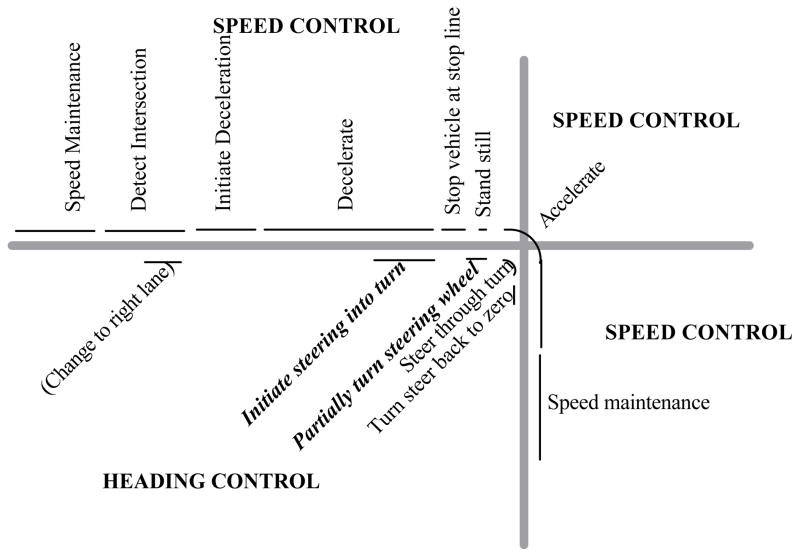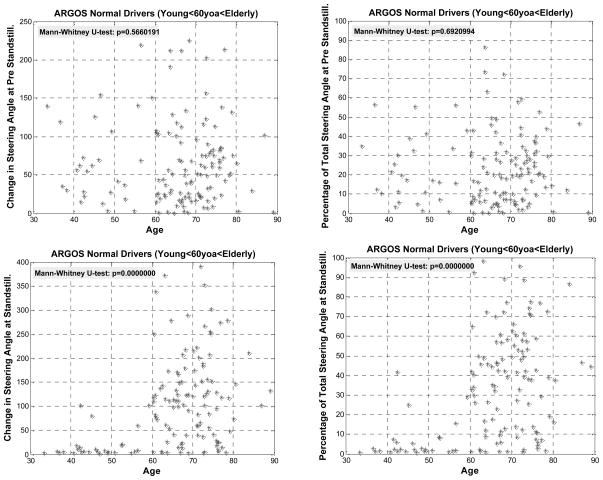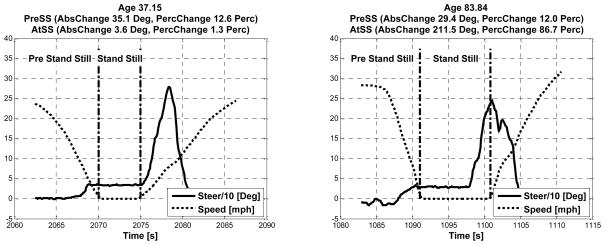Summary
Negotiating intersections is a complex driving task that is particularly difficult for older drivers. This task requires accurate coordination of multiple driving subtasks, placing high demands on perception, attention and motor control that are known to decline with age. We analyzed intersection negotiation behavior in an instrumented vehicle and found striking differences in how drivers of different ages synchronize speed and heading control when turning right. The older drivers performed most of their steering while standing still instead of while accelerating as younger drivers do. This shift from parallel to serial control is a compensatory solution that drivers employ in response to age related decline in perception, cognition, and motor control abilities. Serialization of turning at an intersection reduces attentional demands largely by eliminating the need to switch attention between different driving sub-tasks.
INTRODUCTION
Older drivers are known to adapt their behavior in response to experienced degradations in perception, cognition, and motor control (Langford and Koppel, 2006). These adaptations are comprised of strategic changes such as route choice or time of day selection and tactical changes such as adopted speeds and accepted gaps (Cooper, 1990). These strategic and tactical behavioral changes in older drivers, we hypothesize, arise from functional and operational limitations in perception, decision-making and motor control performance (i.e. reductions in sensitivity, accuracy, speed, and adaptation). Aging drivers experience increasing difficulty in basic dynamic processes required for expedient, accurate, and safe execution of driving tasks (Verhaeghen and Salthouse, 1997), namely: perception, attention shifting, memory management, decision making and motor control.
For a highly over-learned and automatic task such as lane keeping on a relatively uneventful segment of highway, older drivers’ performance is only slightly degraded compared to younger drivers’ performance. However, for multi-tasks such as turning at an intersection, older drivers’ capacities are severely taxed and their performance is substantially degraded compared to younger drivers (Chandraratna and Stamatiadis, 2003).
General slowing of information processing speed with age affects tasks that involve dynamic neuronal processes, such as attention shifting and memory management. Oskvig (1999) reports a slowing of 0.15m/s/yr in the rate action potentials travel along efferent motor axons. Rivner, Shift and Malik (2001) report that nerve conduction velocities decline across an age range from 20 to 90 years in peripheral (sural, peroneal and ulnar) motor nerves (approximately a 0.1% decrease per year), with similar effects on sensory nerves. Central attentional mechanisms such as response inhibition are also affected by cognitive aging (Chow and Nesselroade, 2004). Complex driving tasks that require input from multiple sensory systems and require more central information processing as well as motor control of multiple manipulators consequently show greater decline with age than do simple tasks.
The goal of this study was to test the hypothesis that older drivers show different profiles of operational vehicle control while turning right at intersections without pedestrian crossings compared to younger drivers. Intersections are a particular challenge for older drivers, especially when traffic is present (Garber & Srinivasan, 1991). Tactical aspects of intersection negotiation such as visual search and gap acceptance have been studied more than operational aspects which are the focus of this paper. Vehicle operation at an intersection is difficult for older drivers because it involves synchronous parallel pedal and steering control combined with the need for divided attention across a wide field of view. One possible compensatory adaptation that elderly drivers may employ to simplify the intersection negotiation task is to serialize the tasks. The task of turning at an intersection can be decomposed into multiple stages as depicted in Figure 1. Operational control is separated into speed and heading control. In this task decomposition, attention control to other traffic is omitted because the focus in this paper is on vehicle control.
Figure 1.
Decomposition of speed control (depicted on left side of road) and heading control (right side) when turning right at an intersection
METHOD
The data used for this study were recorded in an insturmented vehicle (ARGOS) that has been used for many on-road studies (e.g., Rizzo, Jermeland, and Severson, 2002; Dawson et al., 2009; 2010). Each subject drove approximately 45 minutes on rural and urban streets around Iowa City with an experimenter present. All drivers had valid driver licenses and were active drivers. In the current analyses, data were included only from all drivers with normal cognitive aging (> 60yo) and comparison drivers (< 60yo). Criteria for exclusion included brain lesions, stroke, vestibular disease, motion sickness, alcoholism, and diagnosed neurological or psychiatric diseases, including depression. Informed consent was obtained from all subjects following protocols from institutional and federal regulatory committees ensuring human safety and confidentiality. ARGOS collects a number of measures of longitudinal and lateral vehicle control (but not GPS data). The resulting dataset contained 66 male and 70 female subjects each with a mean age of 65 years. The age range for male subjects was 33–89 years and for females 36–84 years. The average age for the elderly driver group (>60yo) is 70.5 years and for younger driver group (<60yo) is 49.5 years.
Exploratory analysis showed that older drivers turned their steering wheel substantially more during standstill than younger drivers. To explore this phenomemon in depth, we studied right turns in which the driver would come to a full stop close to the (perpendicular) cross street. Left turns as well as right turns after a pedestrian crossing were not included; in these cases turning the steering wheel while stationary is not a feasible option because the car needs to travel straight before turning onto the cross street. Consequently this study examined all intersections where drivers turned right that satisfied the following criteria:
Maximum steering angle greater than 200°. This assures that they are making a 90° turn and not a 45° turn of which many are present in Iowa City.
Vehicle came to a stop (defined by speed < 0.5mph). This excluded all intersections where a full stop was not required as well as illegal rolling stops. This allowed us to look at driver behavior while standing still.
Steering from straight-on approach (i.e. < 10°) to a maximum greater that 200° and back to straight in less than 50s. This assured that large intersections that most likely had pedestrian crossings between the stop line and the side street were excluded. This allowed us to achieve meaningful comparrisons accross intersections.
Steering less than 20° to the left upon approach. This assured that closely spaced intersections were excluded as well as intersections that required a lane change immediately before turning.
Focus in the analysis is on drivers’ serialization of the vehicle control subtasks as quantified by the following four metrics (shown in Figure 2):
Figure 2.
Amount of steering in anticipation of a right turn while approaching (top row) and while standing still (bottom row) as a function of age
AbsSteerChangeApproach: Absolute number of degrees that the steering wheel is increased during approach (upper left panel).
PercSteerChangeApproach: Percentage of degrees that the steering wheel is increased during approach relative to the maximum angle reached during the full turn (upper right panel).
AbsSteerChangeStandStill: Absolute number of degrees that the steering wheel is increased during standstill (lower left panel).
PercSteerChangeStandStill: Percentage of degrees that the steering wheel is increased during standstill relative to the maximum angle reached during the full turn (lower right panel).
A non-paired Mann-Whitney U-test assessed whether the amount of steering upon approach to and during standstill at an intersection differed significantly between young (<60yo) and elderly (> 60yo) on right turns at intersections. Since each driver negotiated multiple intersections, those samples were not independent and thus the Mann-Whitney U-test could not be applied to all available samples. Therefore, one right-turn intersection was randomly selected from each driver to serve as the one sample per driver.
RESULTS
The drivers over age 60 years old show significantly more steering during standstill than younger drivers. This is shown in the bottom row in Figure 2. The older drivers showed a greater absolute change in steering angle while standing still (lower left with a significance < 1e-7) and also a greater the percentage change in steering angle while standing still relative to the maximum steering angle reached during the right turn (bottom right also with a significance < 1e-7). During the approach to the first stopping moment younger and older drivers do not not differ in how much they steer into the right turn (top row significance values are > 0.5).
Figure 3 shows characteristic example steering profiles for a younger (left) and an older (right) driver in terms of the similar amounts of steering upon approach and different amounts of steering during stand still. The values for the four outcome metrics are indicated in the panel titles. The younger driver (left panel) shows a characteristic limited amount of pre-standstill steering (12.6%) and essentially no steering while standing still (1.3%). The older driver (right panel) shows a similar limited amount of steering during approach (12.0%) and a characteristically large amount of steering during standstill (86.7%).
Figure 3.
Characteristic steering profiles during a right turn at an intersection for a younger (left panel) and an older (right panel) driver
DISCUSSION
This study provides evidence in support of the hypothesis that older drivers serialize their control behavior in right turns at simple intersections more than younger drivers. Serialization manifests in the form of steering during standstill rather than during acceleration. As expected, some elderly drivers show almost no steering during standstill in Figure 2 and thus behave more like younger drivers. However, the majority of elderly drivers show strong serialization.
Turning right at an intersection is a complex task that requires simultaneous heading and speed control. To simplify the task, it is possible to serialize the control behavior by first stopping, then turning, and finally accelerating while steering back to zero, a pattern that we found is adopted in real world driving by older drivers. This adaptive behavior helps mitigate difficulties that older individuals have in switching attention between tasks, such as vehicle control plus monitoring for and tracking other road users (Maki, Zecevic, Bateni, Kirshenbaum and McIlroy, 2001).
Further, when accelerating from a standstill, rapid and accurate steering is required to avoid swerving into a lane with potentially oncoming traffic or off the road where other road users (such as bicyclists and pedestrians) may be present. Such rapid steering movements that are carefully synchronized with speed pose difficulties for older drivers because these maneuvers require fast integration and control of information, which degrades with age (Teasdale, Stelmaeh, Breunig, and Meeuwsen 1991). Synchronized control is especially difficult for older drivers if it is also necessary to simultaneously monitor other traffic and road users. To mitigate these perceptual, attention, and motor control difficulties, older drivers simplify the task of turning right at an intersection by serializing the required tasks, thereby reducing the need for accurate time pressured integration of information and vehicle control. Such a demand reduction frees attention resources to potentially maintain greater situation awareness during the turn.
By turning the steering wheel substantially towards the required peak steering angle while standing still, attention can be directed primarily to speed control while the steering wheel is mostly just returned to zero. Returning the steering angle to zero is less demanding than steering towards an unknown maximum angle because the target angle is clear (i.e. zero). By steering nearly to the maximum required steering angle while standing still, it is only necessary to reach the maximum steering angle while still traveling at a slow speed. Once the maximum steering angle is reached and accelerating to higher speeds, it is only necessary to guide the steer to zero which is much easier mentally and physically because the target is clear as well as the naturally occurring torques on the steering wheel aid return to zero.
The observed serialization of driving behavior occurs at the operational level and provides an important additional adaptation on top of already well known strategic adaptations in terms of time of day and route selections adopted to minimize exposure to complex intersections. Differences between younger and older drivers are also observed in deceleration during approach and acceleration following standstill. These results further support the picture that proportionally more elderly drivers are degraded in their ability to multi-task and perform accurate fine control. They compensate by driving slower, decelerating earlier, coming to an abrupt stop, serializing of heading and speed control where possible, accelerating slowly, etc.
The fact that many older drivers exhibit such strong serialization in turning right at simple intersections (i.e. where the stopline is close to the cross road) suggests that these drivers may be at greater risk in left turns and in larger intersections where it is not possible to begin steering while standing still. This is supported by crash statistics indicating greater involvement of older drivers in left turn accidents than younger drivers (Henriksson and Sagberg, 2010). This paper demonstrates that the problem is likely a combination of the need for dual control of heading and speed combined with time pressured attention switching as well as the well known issue of accurate gap aceptance while pressured by other road users (Chandraratna and Stamatiadis, 2003). Detection of serialization of turning behavior in a driver offers one potential indicator for cognitive decline that can be used in conjunction with other driving behavior indicators to provide valuable insight into a driver’s cognive health.
Acknowledgments
The authors would like to thank Nissan Motor Co., Ltd. for supporting this work and for their continued interest in the effects of age and disease on driving. Data collection in ARGOS was supported by NIH NIA RO1 AG 17177 and NIA R01 AG026027.
References
- Chandraratna S, Stamatiadis N. Problem Driving Maneuvers of Elderly Drivers. Transportation Research Record. 2003;(1843):89–95. [Google Scholar]
- Chow S, Nesselroade JR. General Slowing or Decreased Inhibition? Mathematical Models of Age Differences in Cognitive Functioning. J Gerontol B Psychol Sci Soc Sci. 2004;59(3):P101–P109. doi: 10.1093/geronb/59.3.p101. [DOI] [PubMed] [Google Scholar]
- Cooper PJ. Elderly drivers’ views of self and driving in relation to the evidence of accident data. Journal of Safety Research. 1990 Autumn;21(3):103–113. [Google Scholar]
- Dawson JD, Uc EY, Anderson SW, Johnson AM, Rizzo M. Neuropsychological predictors of driving errors in older adults. Journal of the American Geriatrics Society. 2010;58:1090–1096. doi: 10.1111/j.1532-5415.2010.02872.x. [DOI] [PMC free article] [PubMed] [Google Scholar]
- Dawson JD, Anderson SW, Uc EY, Dastrup E, Rizzo M. Predictors of driving safety in early Alzheimer’s disease. Neurology. 2009;72:521–527. doi: 10.1212/01.wnl.0000341931.35870.49. [DOI] [PMC free article] [PubMed] [Google Scholar]
- Garber NJ, Srinivasan R. Risk Assessment of Elderly Drivers at Intersections: Statistical Modeling. Transportation Research Record. 1991;(1325):17–22. [Google Scholar]
- Henriksson P, Sagberg F. Elderly drivers’ accidents in Norway. 12th International Conference on Mobility and Transport for Elderly and Disabled Persons (TRANSED 2010); Hong Kong. 2–4 June.2010. [Google Scholar]
- Langford J, Koppel S. Older drivers’ safety and mobility: Current and future issues. Transportation Research Part F: Traffic Psychology and Behaviour. 2006 Sep;9(5):309–321. [Google Scholar]
- Maki BE, Zecevic A, Bateni H, Kirshenbaum N, McIlroy WE. Cognitive demands of executing postural reactions: does aging impede attention switching? Neuroreport. 2001;12(16):3583–7. doi: 10.1097/00001756-200111160-00042. [DOI] [PubMed] [Google Scholar]
- Oskvig RM. Special Problems in the Elderly. Chest. 1999;115:158S–164S. doi: 10.1378/chest.115.suppl_2.158s. [DOI] [PubMed] [Google Scholar]
- Rivner MH, Swift TR, Malik K. Influence of Age and Height on Nerve Conduction. Muscle Nerve. 2001;24:1134–1141. doi: 10.1002/mus.1124. [DOI] [PubMed] [Google Scholar]
- Rizzo M, Jermeland J, Severson J. Instrumented Vehicles and Driving Simulators. Gerontechnology. 2002;1(4):291–296. [Google Scholar]
- Teasdale N, Stelmaeh GE, Breunig A, Meeuwsen HJ. Age differences in visual sensory integration. Experimental Brain Research. 1991;85:691–696. doi: 10.1007/BF00231755. [DOI] [PubMed] [Google Scholar]
- Verhaeghen P, Salthouse TA. Meta-analyses of age–cognition relations in adulthood: Estimates of linear and nonlinear age effects and structural models. Psychological Bulletin. 1997;122(3):231–249. doi: 10.1037/0033-2909.122.3.231. [DOI] [PubMed] [Google Scholar]





